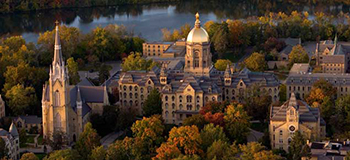Notre Dame Recognized for Continued Sustainability
 NOTRE DAME, Ind. — The University of Notre Dame has strived for years to improve its sustainability efforts and become a model for environmental friendliness.
NOTRE DAME, Ind. — The University of Notre Dame has strived for years to improve its sustainability efforts and become a model for environmental friendliness.
Last month, the school earned a gold rating in recognition of its sustainability achievements from the Association for the Advancement of Sustainability in Higher Education. The association monitors eco-friendly measures through its Sustainability Tracking, Assessment and Rating System (STARS). Scoring a 68.52 out of 100 points through STARS, Notre Dame improved its sustainability score by 17.25 points over three years.
Green Building News spoke with Linda Kurtos, director of the office of sustainability at Notre Dame, about how the school was able to improve its STARS rating and why it’s im-portant to maintain gold status.
Q: How does the STARS rating system set University of Notre Dame apart from other institu-tions?
Kurtos: The STARS rating system is unique because it is a fully transparent system. Every-thing that we report is there for the public to see. It’s unique in that sense and significant because each person can judge what all the reporting institutions are doing. More im-portantly, it’s really significant in that it addresses what universities are doing holistically across the board for sustainability. Instead of just focusing on one area, whether it’s sus-tainable food or sustainable energy or education courses, it really allows the university to show what it’s doing across the board in sustainability, and the rating is based on the totality of the events that you’re doing.
Q: What is the university’s mission for sustainability, and how is the entire campus incorpo-rated in these efforts?
Kurtos: Notre Dame’s Catholic social traditions really push the sense we need to be good stewards of the earth and its resources. That’s really reflected in specific sustainability goals that the university has set. It reflects not only our desire to be good stewards but to be a premier teaching and research institution in this area as well. Our specific sustainability goals are really a good time to have all of that. We do have a goal to reduce emissions, to conserve our resources, and to increase awareness about sustainability through educational outreach both in the Notre Dame community and throughout the broader community.
We’re very devoted to sustainable design. For example, the Morris Inn is a Four-Diamond hotel on campus that just received the LEED Gold certification. We do a lot of things in the areas of design, technology and behavioral change affecting purchase decisions and affect-ing behavioral decisions. Because it’s part of the Catholic mission, we really believe in the people part of the triple bottom line of people, profit and planet. Over 80 percent of our students are active in social services.
We also have a lot of technology that helps improve our sustainability, including automated lighting based on occupancy. We’re also doing some pilot programs on automating different occupational devices and uses.
Additionally, we do education and awareness to make students more aware of the impact that they have. Some of that is through national petitions like RecycleMania. We also have taken our most iconic part of our campus, which is the golden dome, and we’ve improved its lighting efficiency.
Q: Why is it important to be environmentally focused in not only building design, but campus operations?
Kurtos: Our buildings are living buildings. This is a year-round community, so we really want our buildings to be more than just structures. The design [of a building] is very im-portant, but to keep the sustainability of a building, you really have to look at the opera-tions. So, we look to the ways of improving our cleaning processes to be as sustainable as possible. We look to ways to maintain a building because if it’s not maintained properly, then we’re not reaching all the benefits of that.
